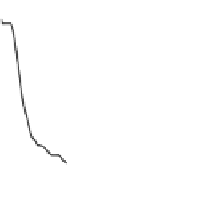Biomedical Engineering Reference
In-Depth Information
patient P1 session 1
twisting movement duration
session 1
session 16
A
C
50
20
100
7
grasping force
angular velocity
6
40
80
10
5
twisting
movement
30
60
4
ine position
adjustment
20
0
40
3
10
20
2
−10
0
0
1
position
−10
−20
−20
0
0
2
4
6
8
0
2
4
6
8
pronation
supination
time [s]
time [s]
patient P1 session 16
B
D
number of oscillations
session 1
session 16
50
20
100
10
grasping force
angular velocity
40
80
8
10
30
60
thumb force
6
20
0
40
4
ingers force
10
20
−10
2
0
0
position
−10
−20
−20
0
0
2
4
6
8
0
2
4
6
8
pronation
supination
time [s]
time [s]
Figure 4.5
Angular position, grasping force and angular velocity during a representative
pronation movement with the HapticKnob for stroke subject P1 (male, 63 years old and 2
years post-stroke) in the first (A) and last session of robot-assisted therapy (B). The duration
of the twisting movement (C, mean over all patients) as well as the oscillations around the
target (D, mean over all patients) decrease for both pronation and supination, while the
coordination between forces applied by thumb and fingers increases.
even after training, the movement duration was longer than for healthy subjects of
the same age group. In addition to the increase in speed, the number of oscillations
to adjust the position around the target orientation decreased
(−
62% in supination
and
24% in pronation,
Fig. 4.5(D)
)
. These results illustrate an important improve-
ment in movement precision and control during tasks involving hand and forearm
coordination.
Similar results were observed in finger movements trained with the Hand-
CARE. In an exercise where subjects were asked to actively extend and then flex the
fingers together, i.e. all fingers moving at the same time, we observed significant
improvement in the coordination between the fingers
−
(+
31% during extension
and
54% during flexion of the fingers). Control of finger motion also improved
during the therapy, as we observed smoother movements
+
(+
6.2% and
+
1.4% in
extension and flexion respectively).
4.4.2 Improved Force Control
Finger independence and finger force generation were trained with the Hand-
CARE. Subjects were instructed to select different letters on a monitor in order
































































































































































































































































































